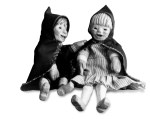Who are the child survivors
It was and continues to be difficult to determine a category in which people count conclusively as child survivors. As a rule, taking 1928 as the year of birth sets the chronological limit. Thus this comprises a group of people who were about 16 when the war ended in 1945. This definition has consequences for those concerned and raises various questions. How do we deal with the fact that a Polish child born in 1929 already suffered Nazi persecution at the age of 10 while a Hungarian child born in the same year avoided this fate until he was 15 and Hungary was occupied by the German troops?
»… the definition was meant to account for an additional phenomenon, namely what happened to youngsters in the immediate postwar period. The vast majority of those under sixteen were placed under some kind of guardianship that led to placements in homes or orphanages and in many instances, a resumption of education. Those over age seventeen were far more likely to insist on a degree of independence and to participate in the decisions about immigration. «
How do the chronological and geographical components affect the history of survival and the trauma experienced? Following this line further leads to the question of how the Shoah might have affected a child born in 1923 that was 10 years old when it experienced the April boycott of 1933 in Germany or was expelled from school?

